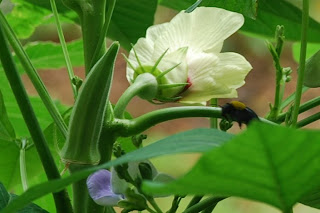We know about grasshoppers habitual munching of leaves, and bees nectar licking. Engineers are used to having buildings over designed . The design far exceeds usual standards as of sturdiness or safety. Plants would probably do the same. They have far more leaves than necessary. I am not too sure what is enough as far as winged beans leaves are concerned. The whole plant is so heavy and dense with leaves.
Probably some are reserved for insects to bite. It is just a romantic view to look at their ecosystem. And nectar can also be seen as what we understand as reward system to keep productivity and enthusiasm high. The plants need insect to help with pollination and has nectar to offer for such service.
Probably some are reserved for insects to bite. It is just a romantic view to look at their ecosystem. And nectar can also be seen as what we understand as reward system to keep productivity and enthusiasm high. The plants need insect to help with pollination and has nectar to offer for such service.
belalang kunyit,
belalang kunyit or Valanga nigricornis
is the biggest grasshopper in Malaysia that I know of, resting on winged bean leaves. According to a laboratory studies on the life-history of Valanga nigricornis ... it requires 6 and a half to 8 and a half months to complete the life cycle. I never knew belalang kunyit lives that long, definitely longer than winged bean itself.
a carpenter bee
a carpenter bee
a carpenter bee
the carpenter bee is undecided; is it okra or bean flower.
the carpenter bee licking nectar of winged bean flower
the carpenter bee
or xylocopa confusa
licking nectar of winged bean flower.
Carpenter bee or Xylocopa confusa
is a large bee reaching slightly more than 20mm. Female is mainly black. The thorax is with deep yellow hairs, making it almost fully yellow except for small black patch at the centre. The species is quite widely distributed across Southeast Asia, definitely a frequent visitor in my garden, hopping from one flower to another. It seems to love every flower available here; coleus, senduduk, winged beans, roselle and okra.
[reference: Xylocopa confusa - Asian Hornet Net]
or xylocopa confusa
licking nectar of winged bean flower.
Carpenter bee or Xylocopa confusa
is a large bee reaching slightly more than 20mm. Female is mainly black. The thorax is with deep yellow hairs, making it almost fully yellow except for small black patch at the centre. The species is quite widely distributed across Southeast Asia, definitely a frequent visitor in my garden, hopping from one flower to another. It seems to love every flower available here; coleus, senduduk, winged beans, roselle and okra.
[reference: Xylocopa confusa - Asian Hornet Net]
bangchik and kakdah, my little vegetable garden









.jpg)
